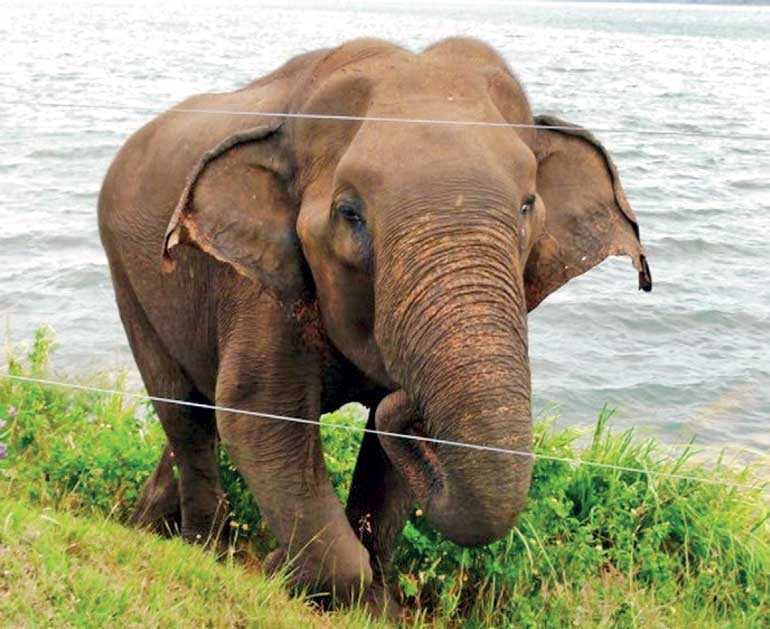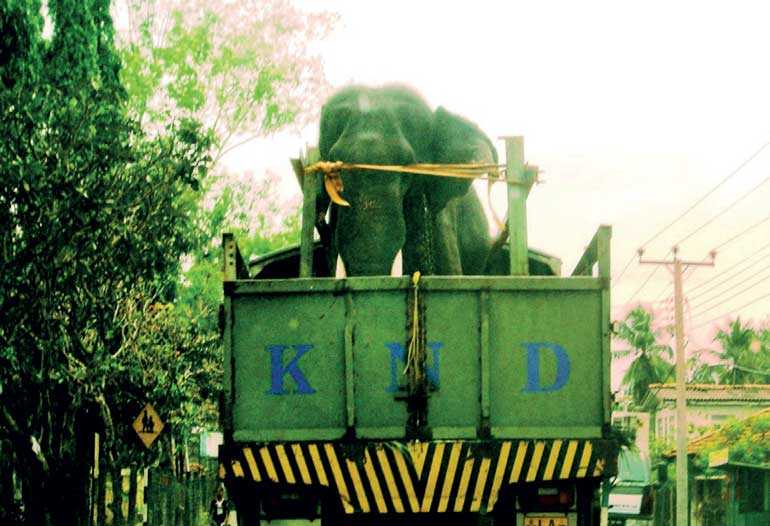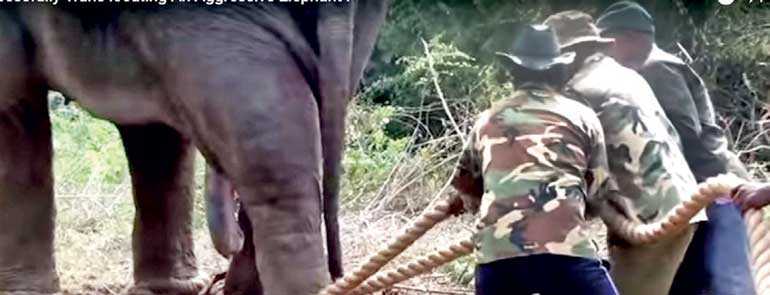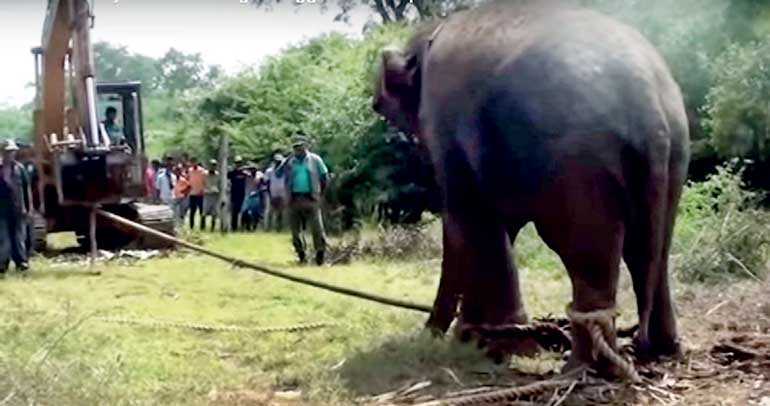Thursday Apr 25, 2024
Thursday Apr 25, 2024
Tuesday, 21 August 2018 00:00 - - {{hitsCtrl.values.hits}}

The subject of translocating wild elephants has been a much-debated topic recently, after the Department of Wildlife Conservation (DWLC), acting on the orders of the Minster for Wildlife, wanted to move the only two wild elephants habituating the Sinharaja Forest Reserve. There were many protests from different organisations, and it was much publicised via social media as well. Eventually saner council did prevail, and the translocation was suspended. Many do not really understand the gravity and pitfalls of wild elephant translocations, although there was a popular uprising against it. Hence this treatise attempts to analyse and explain wild elephant translocations
Introduction
Sri Lanka is said to have a wild elephant population of about 6,500 although exact numbers are not really available, in spite of some form of census that was carried out some years back. This approximately accounts for about 10% of the world Asian elephant populations, the rest being primarily in India, Thailand, Nepal and Borneo. Sri Lanka may have over 18 National Parks, but the reality is that some 65% of these wild elephants are found outside these protected areas.
“With expanding human populations, natural habitats that are not designated as ‘protected’ are being converted to human habitats at an ever increasing rate. Where elephants once ranged have sprung up crop fields, where they once bathed and peacefully drank is now an agricultural reservoir. Every day, elephants are losing ground to the human tide. Their access to critical resources, are blocked by human habitations and fences. When they come out to water or to feed in an open area, they are chased away. Trap guns, muzzle loaders, planks studded with nails left on trails, poison, all take their toll, killing and maiming elephants” – Centre for Conservation & Research (CCR).
Hence the Human Elephant Conflict (HEC) takes heavy toll of wild elephants (over 270 deaths in 2016) and also human beings (88 human deaths recorded in 2016 – Ref DWLC)
Due to the high degree of intelligence of wild elephants, coupled with the expanding human population and unplanned development, finding solutions to the HEC is a very complex task. Piecemeal solutions will not do. Many Sri Lankan elephant researchers have developed good practical solutions to mitigate the issue. What is needed is a holistic, well planned out, all-encompassing strategy, taking into consideration all the available research by private researchers, to be implemented on a nation-wide scale, in a consistent and cohesive manner, without ad-hoc political interventions.

So what is wild elephant translocation?
Translocation of wild elephants means exactly that! Trans-locate – “Move from one place to another” (Oxford Dictionary).
So in reality it is the ‘movement’ of a wild elephant from one area to another. This is normally undertaken (by the DWLC) to move wild elephants, after tranquilisation, who may be causing crop damage and harm to humans in one particular area, to another area which is possibly safer. However in reality this is not the case (as will be discussed later) and almost often it ends up with ‘changing the pillow to get rid of a headache’.
How are wild elephant translocations done?
From the earlier definition translocation seems a rather simple straightforward process. However this simple action becomes very much more complex, when one has to ‘move from one place to another’, a four to five ton, intelligent wild animal, who is stronger than a bulldozer, against its wishes!
This complex process requires quite a lot of planning (unlike some of the quick fire translocations done by the DWC due to political pressure).
Firstly, a proper well-trained team has to be put together, with an experienced veterinary surgeon, to undertake the tranquilisation. After assessing the area where the elephant is, the team will carefully track the elephant.
Choosing the site for tranquilisation is very important, because once tranquilised the elephant has to be quickly ‘loaded’ on to the transportation vehicle (which should be a properly designed one). Hence the area chosen has to be free of large trees and other impediments in a relatively ‘open area’. There should be adequate back-up staff and equipment such as bulldozers, backhoes, and strong tethering manila ropes. This whole procedure of getting the elephant into a suitable area for tranquilisation and transfer onto the transportation lorry may take even days sometimes. If done properly.

The veterinarian will then fire the dart loaded with tranquilising agent to the rump of the elephant. The moment the dart hits the elephant will start to run, and it is imperative that the team follows it, and does not allow it to wander too far by blocking its exit. In a few moments if all goes well, the elephant is subdued and will be in an inactive state (contrary to some beliefs, dosage of the medication does not completely immobilise the elephant and it does not fall on down completely). The legs are noosed and then with the aid of bulldozers the elephant is ‘pulled’ and cajoled into moving closer to the truck. This is a rather cruel process and often the elephant, although in a semi-drugged state, still puts up a fight, pulling at its shackles and even sometimes falling over.
In the meantime the truck is carefully positioned with the rear door flap opened and a ramp made of earth built around it to facilitate the elephant’s movement into the truck. With some effort, if correctly executed, the elephant will be loaded onto the truck and secured. By this time the tranquilising agent would have worn off, to some extent, and the elephant will be doused with water to cool it. This is a very traumatic experience for the animal. Some form of fodder will also be given, but most often the elephant will be in too much of an agitated state to eat.
Then comes the ride to its ‘new home’. Here again there should be careful consideration given to the distance of transportation. There have been instances in the past where animals have been transported long distances, causing great distress and even gruesome fatalities in transit. Once the release site is reached, the rear door of the truck is lowered, a ramp built and the elephant is carefully let lose. With the effects of the tranquilisation fully worn off by now, it will quickly run off into the surrounding area.

Why is translocation done and what are the repercussions?
It is an attempt to get rid of the problem created by a wild elephant which may be crop raiding and causing danger to humans. But as indicated earlier, it really does not solve the problem, and does even aggravate it at times.
Elephants have been found to have their own home ranges. Male elephants are solitary by nature, and constitute almost the entirety of the so-called ‘problem elephants’. They have a larger range than females and herds. These home ranges are very familiar to them, and are ‘mapped out in their brains’. So if they are forcibly re located, they always try to find their way back to their original home grounds.
There is spectacular recorded evidence by Dr. Prithiviraj Fernando, Sri Lanka’s foremost wild elephant researcher and expert, of elephants who have been translocated, even some hundreds of kilometres away from their home range, eventually finding their way back to their original home areas. (Ref Centre for Conservation and Research). The sad part is that in the translocated elephant’s ‘journey’ in finding its way back to familiar territory, it often has to pass through unfamiliar villages and built up areas. There are altercations with humans, some with disastrous consequences of bullet wounds and other injuries, further angering the elephant. Several die during this attempt to relocate back to their home range.
At the other end of the spectrum, the few translocated elephants who do not move back to their familiar territories, manifest aggressive and abnormal behaviour, possibly due to the extreme stress and physio-psychological effects that they underwent. [Chiyo PI, Archie EA, Lee PC, Moss CJ, Alberts SC (2011)].
Hence it is more than evident from hard scientific research and facts, that translocation does not solve the root cause, and may in fact aggravate the issue, or at the most, ‘translocate’ the problem to another area.

Then why do translocations? Are they ethical?
As explained earlier, haphazard and unplanned development has reduced and fragmented the land available for good elephant habitat. Hence basically we have encroached into lands that the wild elephants used for centuries. Due to their strong home ranging behaviour, elephants will not adapt and move away. They continue to stake their claim to ‘their lands’ and thus begins the conflict with man.
A good case in point is the Uda Walawe National Park. It was established in 1972 as a catchment area for the reservoir and it harboured a large population of wild elephants. A few years after 1972 the Government (in its infinite wisdom!) sets up the main sugar cane research facility at Uda Walawe and encouraged farmers to cultivate sugar cane right across the park, separated only by the B427 Thanamalwila Road. Sugar cane to an elephant is like showing candy to a child. In next to no time the elephants were raiding the plantains just ‘outside their designated home’. The DWLC had to spend millions of rupees in setting up not one, but two electric fences to keep the elephants away.
To a great extent wild elephants will give humans a wide berth. But there are some males (males are always solitary) who get used to crop raiding and finding easy and tastier sources of food in plantations. Herds do not resort to such raids because most often they have juveniles in the herd. So it is not surprising to find that few of the adult males get used to this behaviour, and no doubt become a nuisance and in some cases a danger as well. And it is a fact that something has to be done to protect the humans.
However the root cause is not the elephant, but unplanned development and land encroachment. So on an ethical basis there is no case whatsoever in concluding that a marauding elephant is primarily at fault.
The ethical issue is further aggravated when the DWC (supposedly at the instructions of the Minister) recently wanted to translocate two of the remaining elephants in the Sinharaja Forest Reserve, because they were a threat to some people. Sinharaja is a world heritage site, and these few elephants have a right to live there. It is their home. It is the people, venturing into the forest or residing in the border areas illegally, who are at fault. This is why this issue caused such an amount of protests, with even the UNESCO writing to the Government saying that this was not at all acceptable.
Another example is the infamous Rambo, of Uda Walawe fame, who stays on the bund of the reservoir and solicits titbits from passers-by. There was some ideas mooted to translocate this elephant some time ago, but thankfully that idea was shelved. This is an even more interesting ethical issue. This elephant is within the confines of the National Park (standing placidly BEHIND the electric fence) and not harming anyone. If anyone should be prosecuted and found fault with, it should be the people who stop and feed the animal. In any event I am of the opinion that Rambo is so famous that he has done more to promote Sri Lanka and its wildlife, than any high-level, paid, promotional campaign could have achieved. Therefore I believe that Rambo’s value is immense but unfortunately goes unnoticed.
Hence, translocating an elephant does not work, both on scientifically proven grounds, or on ethical basis. However in extreme cases, when all other efforts prove unsuccessful, after careful assessment, a rare translocation may be required.
If not translocation, then what?
At the outset, the root cause for translocations to be considered, it is the HEC, which has to be addressed. As indicated earlier this has to be a national level, well-coordinated and planned effort based, on proper scientific research findings and based on proper data.
Unfortunately in the current context, hoping to see something like this happen seems to be a pipedream.
In the meantime there are some initiatives that could be implemented in the short term. Some researchers have currently conducted case studies on enclosing entire villages in the night by an electric fence, which is proving to be quite effective. (Elephants raid mostly in the night time, and during day the village will have one or more access points to move out, which need to be closed, and the electric circuit re-established in the night). Hence in problem areas such electrified enclosures could be installed. Of course the ideal situation would be to remove the village settlements away if they have been put up illegally. This of course has major political implications and will therefore not happen.
Conclusion
In conclusion it is quite evident that translocation wild elephants to mitigate crop raiding and is not a viable solution at all.
Dr. Prithiviraj Fernando et.al sums the situation lucidly in their research paper: “We conclude that problem-elephant translocation causes intensification and broader propagation of HEC and increased elephant mortality, hence defeats both HEC mitigation and elephant conservation goals. The driver of translocation is public and political pressure. Capturing and translocating an elephant from the vicinity of major HEC incidents may defuse tension hence be of relevance in particular contexts. However we found that even if the original problem is solved by translocation, the same or more likely worse is created at another location. (Ref: Problem-Elephant Translocation: Translocating the Problem and the Elephant? Prithiviraj Fernando, Peter Leimgruber, Tharaka Prasad, Jennifer Pastorini.)